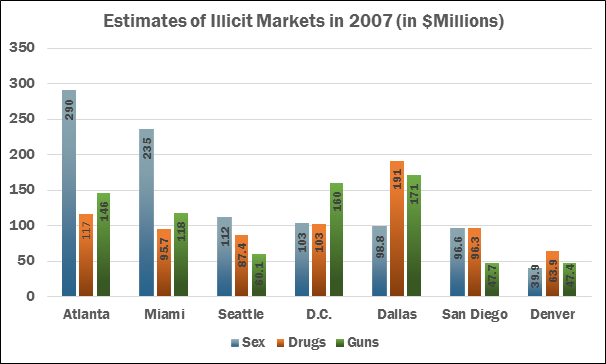"Pimps are like eagles. They soar by themselves." So said one enthusiastic pimp who participated in a new report on America's underground commercial sex economy, metaphorically explaining that he enjoys working alone, rather than in concert with other pimps.
Funded by a $500,000 grant from the Justice Department, and researched and written by the Urban Institute, the landmark study released Wednesday looks at the underground commercial sex economy in eight major cities: Atlanta, Dallas, Denver, Kansas City, Miami, San Diego, Seattle and Washington, D.C. It includes interviews with pimps, prostitutes, traffickers, child pornographers and law enforcement officials, all with an eye toward understanding the trade better.
Related: Porn, Drugs, Hitmen, Hackers — This Is the Deep Web
As of 2007, the underground commercial sex economy was estimated to generate between $39.9 million and $290 million in revenue in each city, with Denver’s being the smallest and Atlanta’s the largest. In the two years examined — 2003 and 2007 — the size of these economies decreased in all but two cities: Seattle and Atlanta. Washington, D.C.'s sex economy suffered the greatest decline.

The researchers seem to have gotten the clearest picture yet of how America's illegal sex trade and trafficking work. "There are no accounting records to trace, no receipts to scrutinize, and no legal records to analyze," says Meredith Bank, the study's lead author. "Simply, it is difficult to grasp the size of this economy."
Unsurprisingly, cash is king, accounting for 66.7 percent of all sex-for-pay transactions. Credit cards are used 10 percent of the time, while trading sex for drugs accounts for another 4.2 percent of transactions. The report also includes fascinating tables such as the one below, detailing how much pimps make (hint: it’s a lot more than the prostitutes make):

Growing Up in the Sex Business
Nearly all the pimps interviewed described themselves as “business managers” – and some even saw the term “pimp” as derogatory. They frown upon drug use by prostitutes, for example – not so much for health reasons as for economics. "Drug use [can] threaten earnings, especially if employees are willing to charge a lower price in exchange for narcotics," the study stated. And while the pimps may have underreported their use of violence, they admitted to psychologically manipulating women into sex work.
Pimps troll bus stations, trains stations and other transportation hubs looking for potential workers, but they also recruit at nightclubs, strip malls, high schools, college campuses and via social media. The study finds that workers got into the sex trade for all the reasons you might expect: family problems, low self-esteem, economic desperation, or a history of sexual victimization. Some pimps report they got into the sex trade because it was all around them growing up. “The community I grew up in was full of prostitutes,” said one. “My mom was a prostitute. I had a sister who was an erotic dancer and another was a prostitute.”
While pimps may see themselves soaring like majestic birds, a far more disturbing image that emerges from the study involves child pornography, specifically the notion among offenders that it's a "victimless crime." One of the study's participants took this stance in light of the apparent fact that very little money changes hands in that world: Images and video are exchanged for free. He or she seemingly forgot about the "child" part of child pornography.
As troubling as that may be, it’s worth understanding for this reason: You have to understand how a black-market economy like this works before you can do something about it — which is the point of this study. As the authors write, "Knowing the size of the economy is the critical first step for enabling law enforcement, the judicial system, and policymakers to make informed choices about how to fight the harm that happens within these black markets."
Top Reads from The Fiscal Times:



